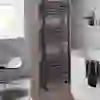Share:
As regularly used bathroom fittings, when heated towel rail problems arise, they can become a source of frustration. Yet, once considered a most luxurious addition, more homeowners are installing a heated towel rail in their bathrooms as a secondary heating element to this space. But, like many other appliances in the home, some heated towel rails can occasionally encounter issues.
Fortunately, most of these issues are small, making them easier problems to resolve. Here at The Bathroom Showroom, we've compiled some expert solutions to help troubleshoot common problems with heated towel rails.
Why Is My Heated Towel Rail Not Working?
Though heated towel rails for the bathroom offer plentiful benefits, it’s always a good idea to be aware of potential issues you may encounter. By knowing what to look out for, you can quickly identify the problem and take the appropriate steps to fix it. There are three typical issues here including the rail doesn't heat up, the rail leaks water, or the rail is noisy in use.

Why Is My Heated Towel Rail Not Heating Up?
One of the most common problems with heated towel rails is a lack of heat. This could be caused by a variety of reasons, such as a faulty thermostat, an airlock in the system, or a build-up of sediment in the pipes.
When troubleshooting a lack of heat in your heated towel rail, start by checking the thermostat. Ensure that it’s set to the desired temperature and functioning correctly. If the thermostat seems to be working fine, the issue may lie with an airlock in the system.
Airlocks can restrict the flow of water and prevent the towel rail from heating up properly. To resolve this, you'll need to bleed the air from the system by opening the air vent.
Additionally, check the condition of the heating towel rail element. Over time, the element may become damaged or worn out, decreasing the heat output and even leading to your heated towel rail not getting hot at all. If this is the case, it will need to be replaced.
For towel rails with uneven heat distribution, try adjusting the position of the rail to ensure proper airflow. Also, check for any obstructions such as curtains or furniture blocking the heat from reaching certain areas. By optimising the positioning and airflow, you can achieve a more even heat distribution.
Alternatively, if your heated towel rail is not generating enough heat, make sure that it’s properly sized for the space it’s installed in. A towel rail that is too small may struggle to heat the room efficiently. Consider upgrading to a larger model if necessary.

Why Is My Heated Towel Rail Leaking Water?
Another common heated towel rail issue is a leaking valve, which can result in water dripping onto the floor or wall, causing damage. If you notice a leaking valve, it’s important to determine if the leak is coming from the valve itself or a connection.
Typically, your heated towel rail may leak due to a range of issues, including:
Loose Connections: This is often the prime culprit. Over time, due to regular use and thermal expansion, connections may loosen, allowing small amounts of water to escape. Over prolonged usage, components of the heated towel rail expand and contract due to heating and cooling. This regular cycle might cause screw connections to loosen, leading to slow leaks. The simple solution here is to tighten any loose connections
Corrosion and Rust: The moisture of the bathroom environment can lead to corrosion and rust in metal towel rails, eventually causing leaks. Prolonged moisture in this room increases the development of rust on your heated towel rail. Over time, this rust may corrode through the metal, resulting in water leakage. The solution here is to ensure your bathroom is correctly ventilated at all times, especially after the bathroom has been used.
Faulty Valves: These crucial components may sometimes fail under constant pressure and temperature fluctuations. Valves control the water flow in your heated towel rail. With constant use, they can wear out over time, causing water to seep through. The simple solution here is to replace any faulty valves.

Why Is My Heated Towel Rail Making a Noise?
The types of noise that may be heard from a problematic heated towel rail range from ticking sounds to strange gurgling noises. Although slightly less common, the noise may even take on a banging or knocking sound.
If your heated towel rail is making a noise, it could be due to trapped air, loose fixing screws, or the water hammer effect. Rectifying the problem usually involves purging the system or tightening the loose screws. In more severe cases, the installation of an air separator or water hammer arrestor might be required. Always consult with a professional if you are unsure of how to proceed. Below are some probable causes of noisy heated towel rails.
Air Trapped in the System: When not installed or maintained properly, air gets trapped in the rail, causing a gurgling sound. Often, the solution is as simple as letting out the trapped air in the system. This can be easily done by bleeding the rail.
Loose Fixing Screws: If the holding screws are not tight enough, they vibrate when the heater operates, producing a ticking noise. If the ticking noise persists after bleeding the rail, it might be due to loose screws. Simply tighten them properly to dampen vibrations.
Water Hammer: This is a phenomenon where water running in the pipes creates a hammering sound due to the sudden closure of the inlet valves. If the water hammer problem is severe, installing an air separator or water hammer arrestor may be necessary.
Heated Towel Rail Problems Are Easily Solved
Overall, troubleshooting common issues with heated towel rails can be a straightforward process if you know what to look for and how to address the problems. By following the expert solutions discussed above, you can easily resolve such common issues, getting your heated towel rail back in fully working order in no time.
If you’re considering adding a heated towel rail, book an appointment with The Bathroom Showroom. Experts in all things bathrooms, we can help turn your dream bathroom into a reality.